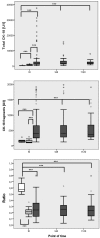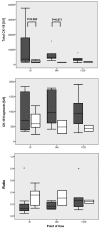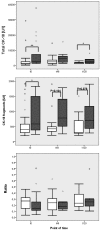Cell death serum biomarkers are early predictors for survival in severe septic patients with hepatic dysfunction
- PMID: 19538738
- PMCID: PMC2717465
- DOI: 10.1186/cc7923
Cell death serum biomarkers are early predictors for survival in severe septic patients with hepatic dysfunction
Abstract
Introduction: Severe sepsis, septic shock, and resulting organ failure represent the most common cause of death in intensive care medicine, with mortality ranging from 40% to 70%. It is still unclear whether necrosis or apoptosis plays the predominant role in severe sepsis. Determining the prevalent mode of cell death would be valuable, as new therapeutic agents (eg, antiapoptotic drugs such as caspase inhibitors) may improve unsatisfactory outcomes in patients with severe sepsis. Furthermore, the prognostic value of newly developed cell death serum biomarkers is of great interest.
Methods: In total, 147 patients (101 patients with severe sepsis, 28 postoperative patients after major abdominal surgery, 18 healthy volunteers) were enrolled. Baseline and clinical data were evaluated. Blood samples from patients with severe sepsis were collected at the time of sepsis diagnosis, and 48 and 120 hours later; samples from healthy volunteers were collected once, and from postoperative patients, once immediately after surgery. We measured caspase-cleaved and uncleaved cytokeratin-18 (CK-18, intermediate filament protein) as a marker of cell death, isolated CK-18 fragments as a marker of apoptosis, as well as IL-6, soluble vascular cell adhesion molecule, and soluble intercellular adhesion molecule.
Results: Age and sex of patients with severe sepsis and postoperative patients were comparable, whereas healthy volunteers were significantly younger. In healthy volunteers, the mode of cellular turnover was primarily apoptotic cell death. Postoperative patients showed comparable levels of apoptotic activity, but necrotic cell death was markedly increased, probably due to surgical tissue injury. In contrast, patients with severe sepsis, and especially non-survivors of the septic group showed increased levels of markers for both apoptotic and necrotic cell death. In severe septic patients with liver dysfunction, necrosis is increased relative to severe septic patients with intact hepatic function. For severe septic patients with liver dysfunction, a cut-off value for caspase-cleaved and uncleaved cytokeratin-18 could be calculated, in order to identify patients at high risk for death due to severe sepsis.
Conclusions: The measurement of caspase-cleaved and uncleaved cytokeratin-18 appears to be an early predictor for survival in severe septic patients with hepatic dysfunction. Furthermore, the loss of parenchymal cells due to necrosis may be the primary mode of cell death in these patients. This may limit possible therapeutic options.
Figures



Comment in
-
Cell death in sepsis: a matter of how, when, and where.Crit Care. 2009;13(4):173. doi: 10.1186/cc7966. Epub 2009 Jul 31. Crit Care. 2009. PMID: 19678906 Free PMC article.
References
-
- Alberti C, Brun-Buisson C, Goodman SV, Guidici D, Granton J, Moreno R, Smithies M, Thomas O, Artigas A, Le Gall JR. Influence of systemic inflammatory response syndrome and sepsis on outcome of critically ill infected patients. Am J Respir Crit Care Med. 2003;168:77–84. doi: 10.1164/rccm.200208-785OC. - DOI - PubMed
Publication types
MeSH terms
Substances
LinkOut - more resources
Full Text Sources
Medical
Research Materials

